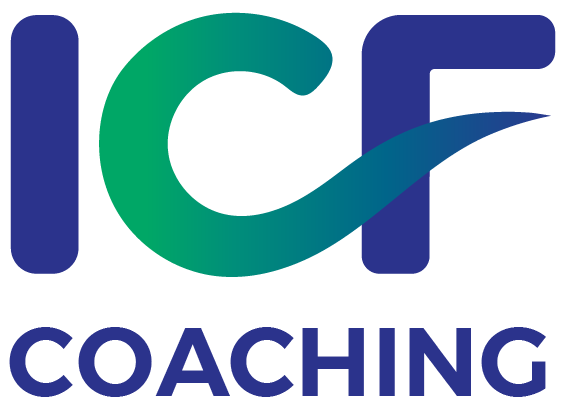Effective Leadership Qualities
The Cornerstone of a Successful Leadership and Development Program
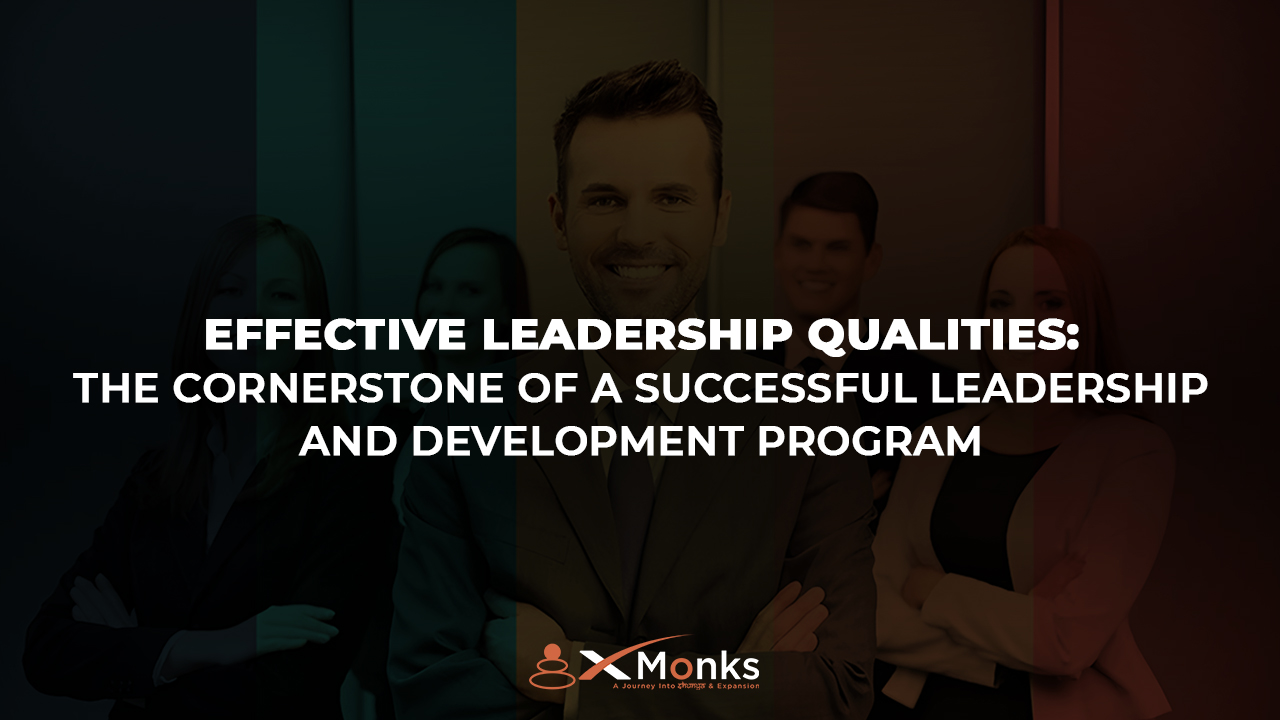
Introduction
Effective leadership qualities are the backbone of any successful organisation. They drive productivity, foster a positive work culture, and pave the way for innovation and growth. But what exactly are the qualities that define an effective leader, and how can organisations cultivate these traits through a well-structured leadership and development program? In this article, we’ll explore the essential leadership qualities that make a difference and how a leadership and development program can nurture these traits to build stronger, more capable leaders.
What Defines Effective Leadership?
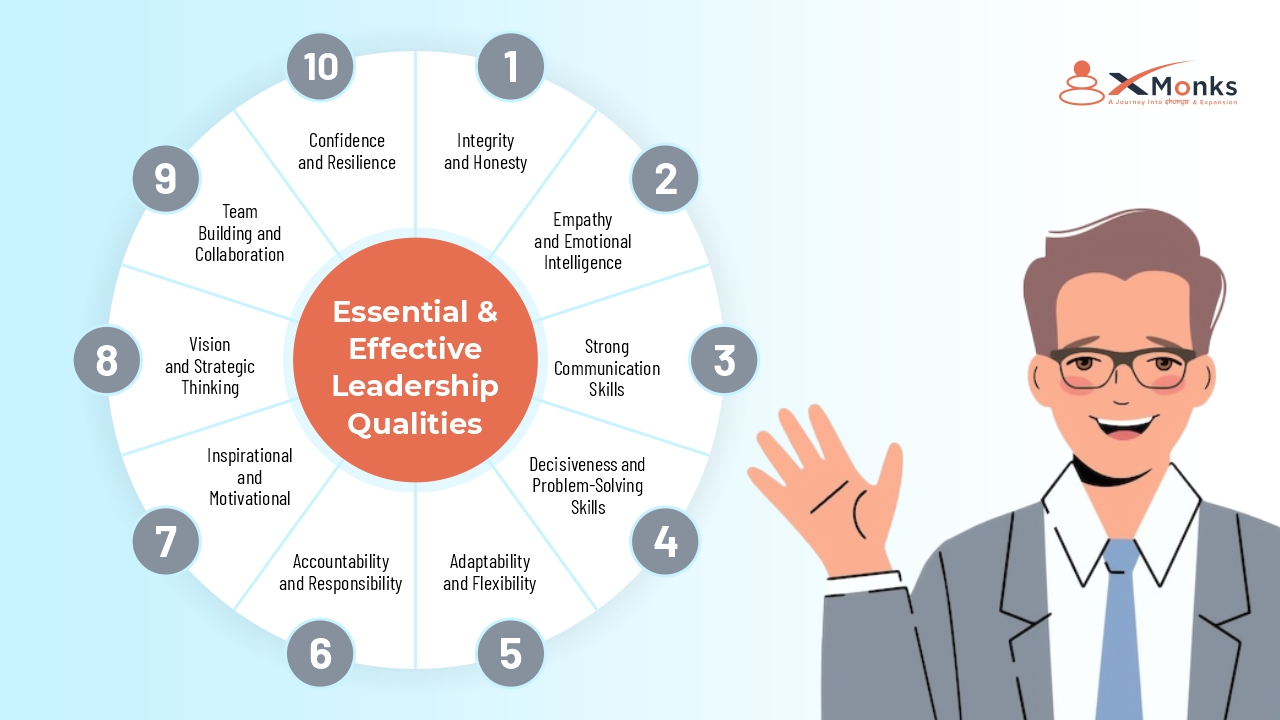
Core Characteristics
Effective leadership is more than just having a title or position. It encompasses a set of core characteristics that enable individuals to guide, inspire, and influence their teams. These characteristics include integrity, empathy, strong communication skills, adaptability, and the ability to make sound decisions under pressure. These are the characteristics that make up the tool kit of effective leadership qualities.
The Role of Vision and Purpose
Vision and purpose are fundamental components of effective leadership qualities, serving as the guiding stars that steer an organisation toward its goals. Leaders who possess a clear vision and a strong sense of purpose can inspire their teams, foster unity, and drive sustained success.
Vision is the ability to see beyond the present, to imagine a future that is better and more prosperous. An effective leader articulates this vision compellingly, creating a shared goal that motivates and energises the entire organisation. This vision provides direction, ensuring that every team member understands the ultimate objective and their role in achieving it. A well-communicated vision helps align the team’s efforts, reducing confusion and enhancing productivity.
Purpose, on the other hand, is the deeper meaning behind the vision. It answers the “why” of the organisation’s existence and the work being done. A leader with a strong sense of purpose infuses their team with passion and commitment. This sense of purpose fosters a culture of dedication and resilience, where employees are not just working for a paycheck but are genuinely invested in the organisation’s mission.
Together, vision and purpose create a powerful synergy. Vision provides the roadmap, while purpose fuels the journey. Leaders who embody these qualities can navigate challenges with confidence and inspire their teams to overcome obstacles. They cultivate an environment where innovation thrives, and everyone is motivated to contribute their best.
In essence, vision and purpose are not just abstract concepts but practical tools that effective leaders use to guide their organisations. By clearly defining and passionately communicating these elements, leaders can create a cohesive, motivated, and high-performing team dedicated to achieving shared goals.
Essential and Effective Leadership Qualities
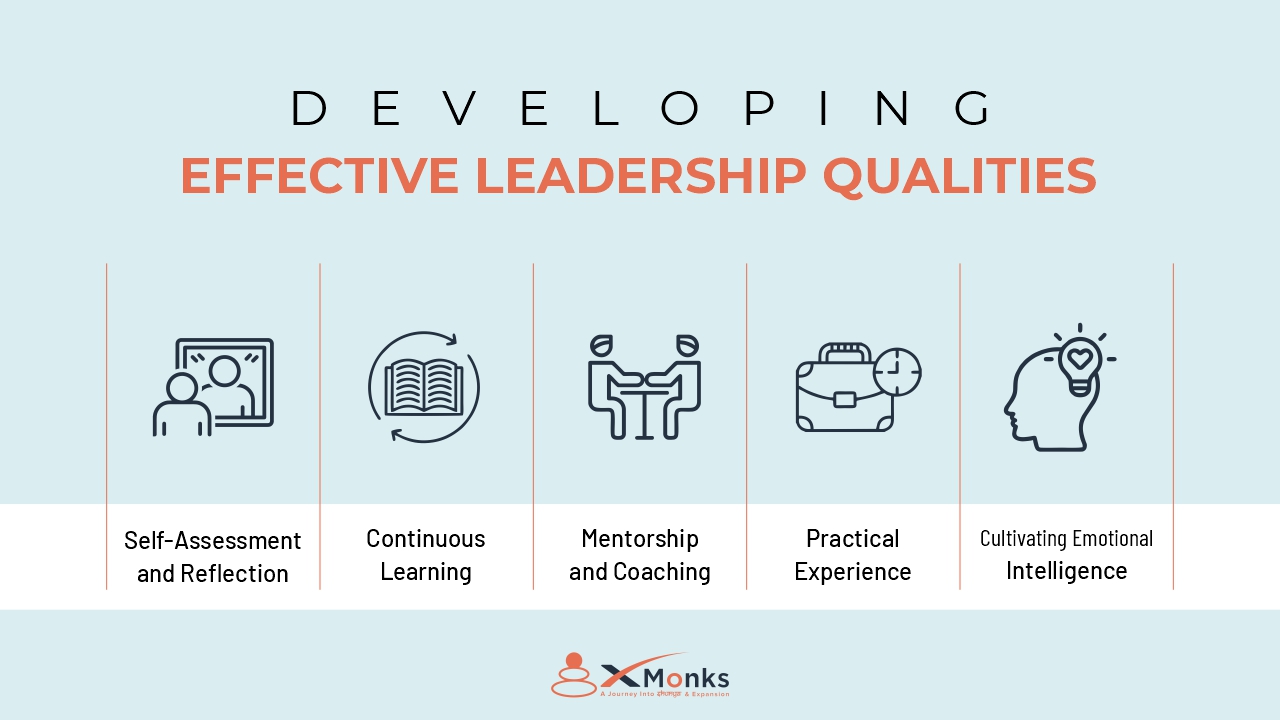
nLeadership is a multifaceted role that requires a diverse set of qualities to guide and inspire a team effectively. The most successful leaders embody a blend of skills and traits that enable them to navigate challenges, foster collaboration, and drive their organisations toward success. Here, we explore the many qualities that constitute effective leadership.
Integrity and Honesty
Primary among effective leadership qualities are Integrity and honesty, which form the foundation of trust between a leader and their team. Leaders who consistently demonstrate these qualities earn the respect and confidence of their team members. Integrity involves making ethical decisions, even when it’s difficult, and honesty means being transparent and truthful. Together, they build a culture of trust, which is essential for effective teamwork and long-term success.
Empathy and Emotional Intelligence
Next among effective leadership qualities is empathy allows leaders to connect with their team on a personal level, understanding their needs, concerns, and motivations. Emotional intelligence (EI) enhances this connection by enabling leaders to manage their own emotions and recognize and influence the emotions of others. Leaders with high EI can navigate interpersonal dynamics more effectively, creating a supportive and productive work environment.
Strong Communication Skills
Effective communication is another one of the effective leadership qualities that are crucial for leadership. Leaders must be able to convey their vision, expectations, and feedback clearly and persuasively. Good communication also involves active listening, ensuring that team members feel heard and valued. By fostering open and honest dialogue, leaders can prevent misunderstandings and build a cohesive team.
Adaptability and Flexibility
In today’s rapidly changing world, adaptability is a key leadership quality. Leaders must be able to pivot and adjust their strategies in response to new challenges and opportunities. Flexibility allows leaders to embrace change and innovation, ensuring that their organisation remains competitive and resilient.
Decisiveness and Problem-Solving Skills
Effective leaders are decisive, able to analyse situations, weigh options, and make informed decisions quickly. This decisiveness is crucial in times of crisis or uncertainty. Coupled with strong problem-solving skills, leaders can navigate obstacles and find solutions that benefit their organisation. This capability builds confidence among team members and stakeholders, reinforcing the leader’s authority.
Accountability and Responsibility
These are effective leadership qualities that should be present in everybody irrespective of their designation. Leaders who hold themselves accountable set a positive example for their team. Taking responsibility for their actions and decisions, even when mistakes are made, demonstrates humility and integrity. This accountability fosters a culture of ownership, where team members are more likely to take responsibility for their work and strive for excellence.
Inspirational and Motivational
Inspirational leaders have the ability to motivate their teams by providing a sense of purpose and direction. They recognize and celebrate achievements, offer encouragement, and maintain a positive attitude. By inspiring their team, leaders can drive higher levels of engagement, productivity, and morale.
Vision and Strategic Thinking
Vision and strategic thinking are two of the most important and effective leadership qualities. A clear vision is essential for effective leadership. Leaders who can articulate a compelling vision for the future provide a roadmap for their team to follow. Strategic thinking enables leaders to plan for the long term, anticipating challenges and opportunities. This forward-thinking approach ensures that the organisation remains focused and aligned with its goals.
Team Building and Collaboration
Effective leaders understand the importance of building strong, collaborative teams. They foster a culture of inclusion and cooperation, where diverse perspectives are valued, and everyone works toward common goals. By promoting teamwork and collaboration, leaders can harness the collective strengths of their team and drive greater innovation and performance.
Confidence and Resilience
Last amongst the effective leadership qualities are confidence and resilience, which are vital for navigating the ups and downs of leadership. Confident leaders inspire trust and respect, while resilience allows them to bounce back from setbacks and continue moving forward. These qualities enable leaders to maintain their composure and effectiveness, even in challenging situations.
The Role of a Leadership and Development Program
In today’s fast-paced business environment, the role of a leadership and development program in cultivating effective leadership qualities cannot be overstated. These programs are designed to equip current and future leaders with the skills and knowledge they need to guide their organisations successfully.
Structured Skill Development
A leadership and development program provides a structured approach to skill development. They cover essential leadership qualities such as communication, decision-making, emotional intelligence, and strategic thinking. By participating in these programs, leaders can systematically improve their capabilities and effective leadership qualities, ensuring they are well-prepared to handle various challenges.
Continuous Learning and Growth
One of the key benefits of a leadership and development program is the emphasis on continuous learning. The business world is constantly evolving, and leaders must stay abreast of the latest trends and best practices. These programs offer ongoing education through workshops, seminars, and online courses, allowing leaders to keep their skills up-to-date and relevant. Thus, continuous learning and growth facilitates effective leadership qualities.
Mentorship and Coaching
Mentorship and coaching are integral components of many leadership development programs. Experienced mentors provide guidance, share insights, and offer feedback based on their own experiences. This relationship fosters personal and professional growth, helping emerging leaders navigate their development journey more effectively.
Practical Application
An effective leadership and development program emphasises practical application of effective leadership qualities. Through real-world projects, role-playing, and simulation exercises, participants can apply what they have learned in a controlled environment. This hands-on experience is invaluable in translating theoretical knowledge into actionable skills.
Building a Leadership Pipeline
By investing in a leadership and development program, organisations can build a robust pipeline of capable leaders who display effective leadership qualities. This proactive approach ensures that there is always a pool of qualified individuals ready to step into leadership roles as needed, contributing to the organisation’s long-term success.
Customisation to Organisational Needs
An effective leadership and development program is tailored to the specific needs of the organisation. This customisation ensures that the program addresses the unique challenges and opportunities faced by the organisation, making it more relevant and impactful.
Developing Effective Leadership Qualities
Developing effective leadership qualities is a crucial factor in the success of any organisation. Developing these effective leadership qualities requires a commitment to personal growth, continuous learning, and practical experience. Here’s how aspiring leaders can cultivate the traits needed to inspire and guide their teams.
Self-Assessment and Reflection
The journey to becoming an effective leader begins with self-awareness. Self-assessment tools and reflective practices help individuals identify their strengths and areas for improvement. Understanding one’s own behaviour, motivations, and impact on others is fundamental to personal development.
Continuous Learning
Leadership is an ever-evolving field. To stay relevant, leaders must engage in continuous learning. This can be achieved through formal education, such as courses and certifications, as well as informal methods like reading, attending seminars, and participating in webinars. Staying informed about the latest trends and best practices in leadership ensures that leaders can adapt to changing environments.
Mentorship and Coaching
Mentorship and coaching provide valuable guidance and support. Experienced mentors offer insights from their own leadership journeys, helping mentees navigate challenges and seize opportunities. Professional coaches, on the other hand, assist in honing specific skills and behaviours. Both mentorship and coaching foster growth and development, providing a framework for aspiring leaders to follow.
Practical Experience
Theory alone is not enough to develop effective leadership qualities; practical application is essential. Taking on leadership roles in projects, volunteering for cross-functional teams, and seeking opportunities to lead in everyday situations provide real-world experience. This hands-on approach allows individuals to apply their knowledge, refine their skills, and build confidence.
Cultivating Emotional Intelligence
Emotional intelligence (EI) is a key component of effective leadership. Developing EI involves improving self-awareness, self-regulation, empathy, and social skills. Leaders with high EI can manage their own emotions and understand and influence the emotions of others, creating a positive and productive work environment.
Implementing a Leadership and Development Program
Designing an effective leadership and development program aimed at developing effective leadership qualities involves several key steps: assessing organisational needs, defining program objectives, developing a curriculum, and selecting the appropriate training methods. Engaging key stakeholders in the design and implementation of the program ensures buy-in and support from all levels of the organisation. This involvement is crucial for the program’s success and sustainability.
Setting clear, measurable goals helps track the progress and effectiveness of the leadership and development program. These goals should align with the organisation’s overall objectives and provide a benchmark for evaluating success.
Training Techniques for Leadership Development
Workshops and seminars offer interactive learning experiences, allowing leaders to develop new skills and knowledge in a collaborative setting. Role-playing and simulation exercises provide hands-on experience in dealing with real-world scenarios, helping leaders develop practical skills and confidence. Assigning real-world projects and assignments gives leaders the opportunity to apply their skills in a practical context, reinforcing learning and promoting growth.
Measuring the Success of ‘Effective Leadership Qualities’ Programs
Measuring the success of programs aimed at developing effective leadership qualities is crucial for ensuring their impact and continuous improvement. While leadership development is inherently complex, several key metrics can provide valuable insights into a program’s effectiveness.
Employee Engagement and Satisfaction
One of the primary indicators of a successful leadership and development program is increased employee engagement and satisfaction. Surveys and feedback tools can gauge how employees feel about their leaders and the overall work environment. High levels of engagement often reflect well-developed leadership qualities, such as effective communication, empathy, and the ability to inspire.
Performance Metrics
Quantitative performance metrics are essential for evaluating a leadership and development program. These metrics can include productivity levels, project completion rates, and overall team performance. An upward trend in these areas suggests that the leadership development initiatives are effectively enhancing leaders’ abilities to guide their teams and achieve organisational goals.
Retention Rates
Displaying effective leadership qualities directly impacts employee retention. A successful leadership program should result in higher retention rates, as employees are more likely to stay with an organisation that invests in strong, supportive leaders. Tracking retention rates before and after implementing leadership programs provides clear evidence of their success.
360-Degree Feedback
360-degree feedback is a comprehensive tool that involves collecting input from a leader’s peers, subordinates, and supervisors. This holistic approach provides a well-rounded view of a leader’s performance and development areas. Improvements in feedback scores over time indicate the effectiveness of the leadership and development program.
Leadership Competency Assessments
Regular assessments of leadership competencies can measure the growth of specific skills targeted by the leadership and development program. These assessments, conducted through self-evaluations and third-party evaluations, help identify progress and areas needing further improvement.
Key Performance Indicators (KPIs)
Key performance indicators (KPIs) are essential for measuring the success of leadership development programs. Common KPIs include employee engagement, team performance, and leadership competency levels.
Challenges in Developing Effective Leadership Qualities
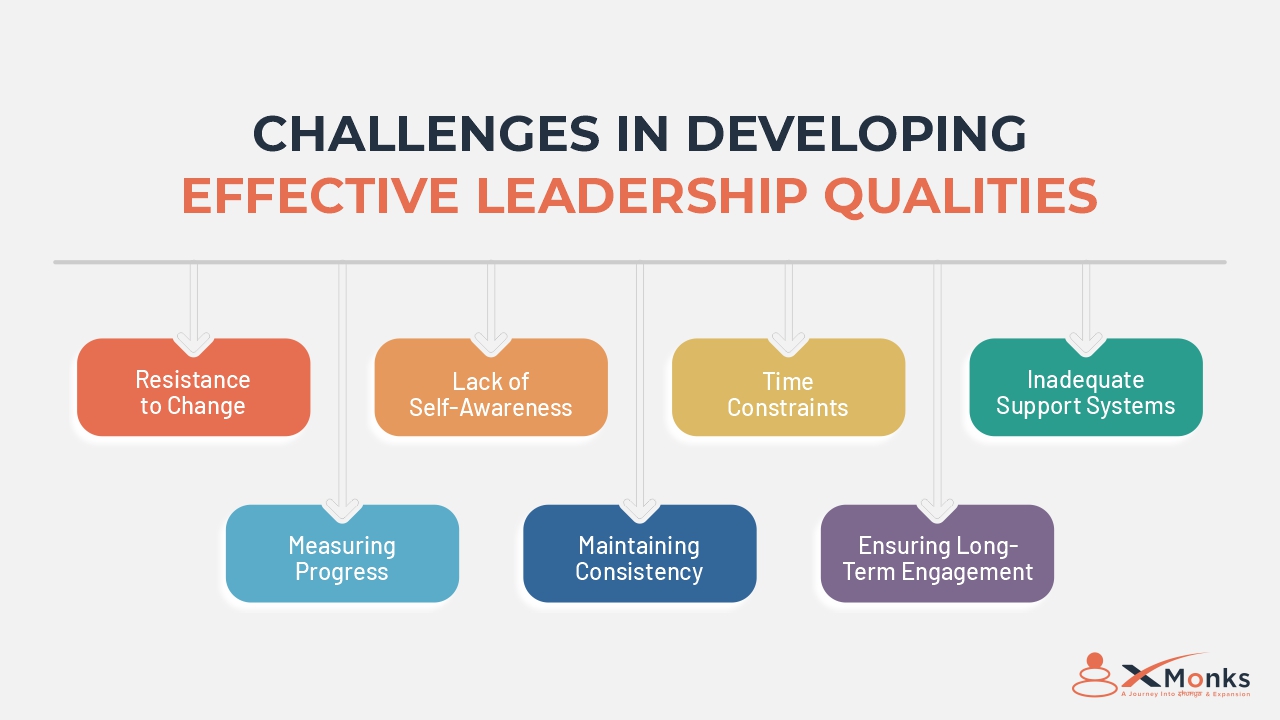
Developing effective leadership qualities is a vital yet challenging endeavour for individuals and organisations. The journey to becoming a great leader is fraught with obstacles that can hinder progress if not addressed properly. Here are some of the key challenges in developing effective leadership qualities.
Resistance to Change
One of the biggest challenges in leadership development is overcoming resistance to change. People often feel comfortable with their established ways of thinking and acting. Introducing new leadership styles and behaviours can be met with scepticism or outright resistance. Effective change management strategies are essential to help individuals and teams embrace new concepts and practices.
Lack of Self-Awareness
Self-awareness is crucial for personal growth, yet many aspiring leaders struggle with it. Without a clear understanding of their strengths, weaknesses, and impact on others, leaders cannot effectively develop their skills. Tools such as self-assessment questionnaires and 360-degree feedback can help increase self-awareness, but they must be used thoughtfully and with guidance.
Time Constraints
Developing effective leadership qualities requires a significant investment of time, which can be a major barrier. Busy schedules and pressing responsibilities often leave little room for reflection, training, and personal development. Prioritising leadership growth and integrating it into daily routines can help mitigate this challenge.
Inadequate Support Systems
Effective leadership development relies on robust support systems, including mentorship, coaching, and access to resources. Many organisations lack these support structures, leaving leaders to navigate their development on their own. Establishing a strong network of support can provide the guidance and encouragement needed for effective growth.
Measuring Progress
Quantifying leadership development is inherently challenging. Unlike technical skills, leadership qualities are often intangible and harder to measure. Developing clear metrics and regular assessment methods can help track progress and identify areas for improvement.
Maintaining Consistency
Sustaining newly developed effective leadership qualities over the long term is another significant challenge. Without ongoing reinforcement and practice, it’s easy to revert to old habits. Continuous learning opportunities and regular feedback are essential to maintain and refine leadership skills.
Ensuring Long-Term Engagement
Maintaining long-term engagement in a leadership and development program can be difficult. Strategies to ensure sustained engagement include ongoing support, regular check-ins, and opportunities for continued learning and growth.
The Future of Leadership Development
The future of leadership development is likely to be shaped by several key trends, including increased emphasis on emotional intelligence, diversity and inclusion, and the integration of technology and AI in training programs. Technology and AI are revolutionising leadership development. From virtual reality training to AI-driven analytics, these tools offer new opportunities for enhancing leadership skills and measuring the leadership and development program effectiveness.
Conclusion
Effective leadership qualities are essential for the success of any organisation. By fostering these qualities through a well-designed leadership and development program, organisations can build a strong foundation for future growth and success. Continuous learning, adaptability, and a commitment to excellence are key to developing effective leaders who can navigate the complexities of today’s business environment.
